- Home
- About
- Map
- Trips
- Bringing Boat West
- Migration West
- Solo Motorcycle Ride
- Final Family XC Trip
- Colorado Rockies
- Graduates' XC Trip
- Yosemite & Nevada
- Colorado & Utah
- Best of Utah
- Southern Loop
- Pacific Northwest
- Northern Loop
- Los Angeles to NYC
- East Coast Trips
- 1 Week in Quebec
- Southeast Coast
- NH Backpacking
- Martha's Vineyard
- Canadian Maritimes
- Ocracoke Island
- Edisto Island
- First Landing '02
- Hunting Island '02
- Stowe in Winter
- Hunting Island '01
- Lake Placid
- Chesapeake
- Provincetown
- Hunting Island '00
- Acadia in Winter
- Boston Suburbs
- Niagara Falls
- First Landing '99
- Cape Hatteras
- West Coast Trips
- Maui
- Mojave 4WD Course
- Colorado River Rafting
- Bishop & Death Valley
- Kauai
- Yosemite Fall
- Utah Off-Road
- Lost Coast
- Yosemite Valley
- Arizona and New Mexico
- Pescadero & Capitola
- Bishop & Death Valley
- San Diego, Anza Borrego, Joshua Tree
- Carmel
- Death Valley in Fall
- Yosemite in the Fall
- Pacific Northwest
- Utah Off-Roading
- Southern CA Deserts
- Yosemite & Covid
- Lake Powell Covid
- Eastern Sierra & Covid
- Bishop & Death Valley
- Central & SE Oregon
- Mojave Road
- Eastern Sierra
- Trinity Alps
- Tuolumne Meadows
- Lake Powell Boating
- Eastern Sierra
- Yosemite Winter
- Hawaii
- 4WD Eastern Sierra
- 4WD Death Valley +
- Southern CA Deserts
- Christmas in Tahoe
- Yosemite & Pinnacles
- Totality
- Yosemite & Sierra
- Yosemite Christmas
- Yosemite, San Diego
- Yosemite & North CA
- Seattle to Sierra
- Southwest Deserts
- Yosemite & Sierra
- Pacific Northwest
- Yosemite & South CA
- Pacific Northwest
- Northern California
- Southern Alaska
- Vancouver Island
- International Trips
- Index
- Tips
- Books
- Photos/Videos
- Search
- Contact
Arcadia Hotel München Airport
Monday, May 22, 2017 - 10:30am by Lolo0 miles and 0 hours from our last stop - 1 night stay
Travelogue
 MaypoleKnowing we would be exhausted, confused, and jetlagged upon our arrival, we had reserved a room ahead of time at a hotel that had a shuttle from the airport. Despite some bad reviews about their unreliable shuttle, there it was as soon as we exited the Baggage Claim area.
MaypoleKnowing we would be exhausted, confused, and jetlagged upon our arrival, we had reserved a room ahead of time at a hotel that had a shuttle from the airport. Despite some bad reviews about their unreliable shuttle, there it was as soon as we exited the Baggage Claim area.
The hotel was fine, clean and comfortable and in walking distance to a good Italian restaurant - that’s right, it was my first night in Germany and I was going to have a pizza.
The room looked like a typical American hotel room with the exception of the bed. Rather than a single comforter on the double bed, there were two twin-sized duvets folded in half, laid side-by-side on the bed. Herb loved the concept as he often accused me of “tucking and rolling,” leaving him uncovered on many a cold night. Also, there was no flat sheet between the fitted sheet and the duvet. We would find this same setup in our Munich hotel as well.
After a quick nap, we took a walk around the small, but quaint town of Oberding, my very first German village. I just couldn’t resist posing beside the maypole. I wonder if the villagers could tell I was a tourist.
There weren’t very many restaurants in town, but fortunately there was Il Casale, a reasonably priced and highly rated Italian restaurant with a lovely outdoor dining area. I had fully expected to have bratwurst and beer on my first night in Germany, but instead we had a very tasty artisan pizza and a beer. There would be plenty of time for bratwurst later.
The next morning we took the hotel shuttle back to the airport, so we could catch a train into Munich where we would be staying for the next three nights.
Description
The Arcadia is a 3-star hotel located in Oberding, Germany close to the Munich Airport, which offers a shuttle (charge) to and from the airport.
Home
Saturday, April 29, 2017 - 2:45pm by Lolo187 miles and 4 hours from our last stop - 1 night stay
South Lake Tahoe
Friday, April 28, 2017 - 2:45pm by Lolo150 miles and 3.5 hours from our last stop - 1 night stay
Travelogue
 Heavenly Village GondolaIt was already pretty late in the afternoon by the time we finished exploring the Long Valley hot springs area, so rather than drive all the way home, we decided to stop in South Lake Tahoe, a place we have enjoyed numerous times before, both in summer and in winter.
Heavenly Village GondolaIt was already pretty late in the afternoon by the time we finished exploring the Long Valley hot springs area, so rather than drive all the way home, we decided to stop in South Lake Tahoe, a place we have enjoyed numerous times before, both in summer and in winter.
As with Lee Vining and Bishop, wish we also love, this time we were just passing through, so this trip stop write-up does not do justice to all the wonderful things there are to see and do in this area. For that, I refer you to our visit in 2015:
http://www.cross-country-trips.com/south-lake-tahoe-area
 Toast to a successful tripWe got a room at the comfy and reasonably priced Big Pines Mountain House, just a short distance from the Heavenly Ski Area. As we often do, we used our Yelp app to find a place to eat and chose the highly reviewed Base Camp Pizza, located right near the Heavenly Gondola. Apparently, we weren’t the only ones that knew about this place, because it was packed, and we had to wait almost an hour before being seated. The area around the gondola was a nice place to wait. We even played a game of Corn Hole right outside the restaurant’s bar. The restaurant did not disappoint – the pizza was good, the service was fast, and the beer recommendation was right on.
Toast to a successful tripWe got a room at the comfy and reasonably priced Big Pines Mountain House, just a short distance from the Heavenly Ski Area. As we often do, we used our Yelp app to find a place to eat and chose the highly reviewed Base Camp Pizza, located right near the Heavenly Gondola. Apparently, we weren’t the only ones that knew about this place, because it was packed, and we had to wait almost an hour before being seated. The area around the gondola was a nice place to wait. We even played a game of Corn Hole right outside the restaurant’s bar. The restaurant did not disappoint – the pizza was good, the service was fast, and the beer recommendation was right on.
Over dinner, we reflected on the trip, which was very different both in terms of length and form of travel. Although there were times I very much missed the motorhome – particularly the night where we battled wild burros outside our tent – the change had been fun. It’s good to mix things up once in awhile.
Description
Lake Tahoe is one of the highest elevation lakes (6,255 feet high) in the U.S., as well as the second deepest (1,645 feet deep) – Crater Lake is the deepest. It is located along the border between California and Nevada. The four shores of the lake are each quite different. The north is quiet and upscale, the west and east are more rugged and less developed, and the south shore is busy and tacky with neon-lit hotels and casinos. The 72-mile drive around the lake is very scenic.
Lake Tahoe is known for its clear blue and green waters and the panorama of mountains that surround it on all sides. It is a year-round destination with swimming, boating, kayaking, and various other kinds of water sports during the summer; hiking, backpacking, and camping all year round; and tremendous skiing and snowboarding in the winter.
Two interesting nearby sites we did enjoy, include:
Long Valley Primitive Hot Springs
Friday, April 28, 2017 - 1:15pm by Lolo57 miles and 3 hours from our last stop
Travelogue
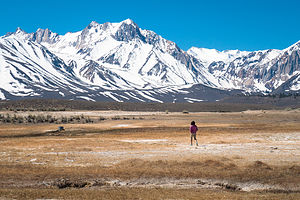 Long Valley Primitive Hot SpringsToday our plan was to find, and hopefully soak in, a few of the many unspoiled, primitive hot springs in the Long Valley area, just south of Mammoth Lakes. We had been on this stretch of road so many times without realizing that the opportunity for a scenic hot soak was just a short dirt-road drive away.
Long Valley Primitive Hot SpringsToday our plan was to find, and hopefully soak in, a few of the many unspoiled, primitive hot springs in the Long Valley area, just south of Mammoth Lakes. We had been on this stretch of road so many times without realizing that the opportunity for a scenic hot soak was just a short dirt-road drive away.
Most of the land in the Long Valley is owned by the Los Angeles Department of Water and Power (LADWP) and the BLM. As a result, it has fortunately not been commercially developed, as so many other hot springs in California. While the LADWP allows day use, the BLM land has no restrictions on overnight camping.
To guide us on our quest, we had the Falcon book entitled “Touring Hot Springs California and Nevada,” which gave a very detailed description of half a dozen of these hidden gems and how to find them.
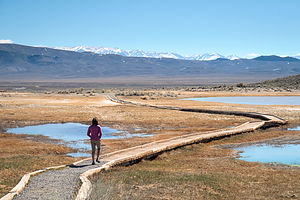 Approach to Crowley's Hot SpringWe began our adventure by turning right (east) off of 395 onto the paved Benton Crossing Road by the big green church. From there, we drove 3.1 miles, crossing two cattle guards, before turning right onto a small dirt road, which we followed for another 1.2 miles before coming to a parking area just past a large rock outcrop for Crowley Hot Spring, also known as Wild Willy’s. Although there is no camping allowed in the parking lot, there are several areas to camp nearby.
Approach to Crowley's Hot SpringWe began our adventure by turning right (east) off of 395 onto the paved Benton Crossing Road by the big green church. From there, we drove 3.1 miles, crossing two cattle guards, before turning right onto a small dirt road, which we followed for another 1.2 miles before coming to a parking area just past a large rock outcrop for Crowley Hot Spring, also known as Wild Willy’s. Although there is no camping allowed in the parking lot, there are several areas to camp nearby.
After parking the car, we strolled along a wooden boardwalk, built by the BLM to protect the vegetation, to the springs and the pools. There were two of them – one built of concrete with a wooden deck, about 9 by 12 feet and 3 feet deep, and the smaller, more primitive one with a mud bottom. As expected, they were both already occupied. It was really quite cold out (about 45 degrees), so I am sure the 95 degree water was quite inviting. However, rather than get wet so early in our exploration, we decided to continue on, hoping to find a pool that we could have to ourselves.
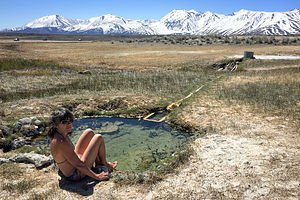 Testing the Waters in Alkali Lake Hot SpringWe drove back out to Benton Crossing Road where we turned right to continue another 0.3 miles to the turnoff for the Hilltop Hot Spring, also known as Pulky’s Pool. From there, it was only a quarter mile drive along a decent dirt road to the parking lot where a few other cars were parked - looked like this one wouldn’t be empty either. We walked a short distance to the top of a hill to find a lovely concrete tub (for about 4 people) with fantastic views of the snow-covered Sierra Mountains. Although empty at the time, it did not remain so for long, so we continued on to the next one – the Alkali Lake Hot Spring.
Testing the Waters in Alkali Lake Hot SpringWe drove back out to Benton Crossing Road where we turned right to continue another 0.3 miles to the turnoff for the Hilltop Hot Spring, also known as Pulky’s Pool. From there, it was only a quarter mile drive along a decent dirt road to the parking lot where a few other cars were parked - looked like this one wouldn’t be empty either. We walked a short distance to the top of a hill to find a lovely concrete tub (for about 4 people) with fantastic views of the snow-covered Sierra Mountains. Although empty at the time, it did not remain so for long, so we continued on to the next one – the Alkali Lake Hot Spring.
Although we carefully kept track of the mileage to the turnoff (0.8 past Hilltop Hot Spring; 4.2 from start of Benton Crossing Road), we passed the turnoff, because we saw a gate and thought it was private. However, after finding no other option, we made a u-turn and returned to the place with the gate. This was it. We parked the car, opened the gate and walked across a marshy area to the spring, which was a small concrete-lined tub fed through a PVC pipe by a hot spring source a few yards away. There was no one in it – I had no more excuses to avoid getting down to bathing suit in this cold weather. Herb, with his body fat content of 11% said he would take pictures. I quickly undressed and put my foot in the pool, only to find that it was way too hot. I started to feel like one of the three bears – “this one is too crowded,” “this one is too hot.”
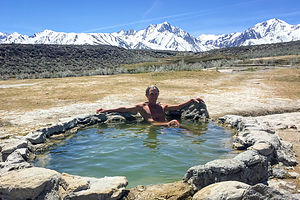 Herb in the Crab CookerWe forged on in search of the “Crab Cooker” – not sure how something called a crab cooker was going to be any cooler than the Alkali Lake Hot Spring. Also, our Falcon Guide said that the tub had been dry in recent years, so our chances for soaking in it were slim. We decided to do an exploratory anyway, and I am certainly glad we did.
Herb in the Crab CookerWe forged on in search of the “Crab Cooker” – not sure how something called a crab cooker was going to be any cooler than the Alkali Lake Hot Spring. Also, our Falcon Guide said that the tub had been dry in recent years, so our chances for soaking in it were slim. We decided to do an exploratory anyway, and I am certainly glad we did.
Our Falcon Guide had a fairly detailed map, so we improvised and took a turnoff from the Benton Crossing Road rather than go back to the Whitmore Tubs Road junction, from which the directions in the book were given. This road was much rougher and definitely not doable by 2WD. Eventually we bounced our way to a parking lot, which had one other car in it. From the parking lot, we could see a lovely little pool built out of rocks and cement that very definitely was not dry – probably the result of the near record breaking rains this winter. It had one inhabitant in it, but he was just getting out and drying himself off. The views of the snowy Sierras beyond it were incredible.
This one looked “just right.” Even Herb agreed and we quickly rushed down to it before anyone else arrived. We spent a wonderful half hour soaking in its perfectly temperatured water while gazing at the mountains. To get this experience in a commercial hot spring would have cost hundreds of dollars, and it still would be well worth it. However, it was much more satisfying getting it for free.
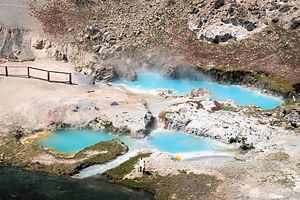 Hot Creek Geothermal AreaAfterwards, we discovered that the road to the Crab Cooker did not go on to the Shepherd Hot Spring as the map in the guide book indicated, but dead ended. However, you could walk to it from the Crab Cooker parking lot, which we did just to see it. It was another nice pool, with two inhabitants in it.
Hot Creek Geothermal AreaAfterwards, we discovered that the road to the Crab Cooker did not go on to the Shepherd Hot Spring as the map in the guide book indicated, but dead ended. However, you could walk to it from the Crab Cooker parking lot, which we did just to see it. It was another nice pool, with two inhabitants in it.
We drove back over the rough road, but made a turnoff to the Whitmore Tubs Road rather than go all the way back to Benton Crossing Road because we wanted to stop at the Hot Creek Geothermal Area, which is now closed to bathing because of scalding temperatures, but still interesting and pretty to visit. From a fenced walkway, we looked down upon two beautiful aquamarine hot springs feeding into a winding cold-water creek. This must have been a fabulous place to soak before conditions changed making it dangerously hot. Hopefully, this will not happen to the other pools in Long Valley.
What a great discovery Long Valley had been. I am very definitely sure that we will be back!
Description
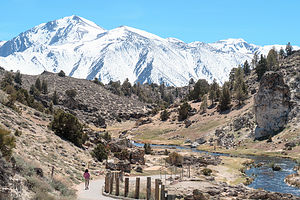 Hot Creek Geothermal AreaThe Long Valley Primitive Hot Springs area, just east of Highway 395 a few miles south of Mammoth Lakes, contains one of the best collections of primitive, unspoiled hot springs in California.
Hot Creek Geothermal AreaThe Long Valley Primitive Hot Springs area, just east of Highway 395 a few miles south of Mammoth Lakes, contains one of the best collections of primitive, unspoiled hot springs in California.
Most of the land in the valley is owned by the Los Angeles Department of Water and Power (LADWP) and the BLM. While the LADWP allows daytime use, the BLM areas also allow camping. LADWP land is marked with large white signs.
The valley is a hotbed of constant seismic and volcanic activity, created by an eruption about 760,000 years ago, in which the volcano collapsed, forming a massive caldera, which is now the valley. The area is still volcanically active, and recent renewed earthquake activity has caused concern that another eruption is in the making.
Benton Crossing Road, which is paved, is the main access road to the springs. From this road, dirt roads of varying quality (some graded and some quite rough) lead to the springs. Some of the more popular springs include:
- Crowley Hot Spring (Wild Willy’s)
- Hilltop Hot Spring (Pulky’s Pool)
- Alkali Lake Hot Spring
- The Crab Cooker
- Shepherd Hot Spring
Bishop
Thursday, April 27, 2017 - 10:15am by Lolo85 miles and 3.5 hours from our last stop - 1 night stay
Travelogue
 Erick Schat's Bakery MobileWe have been to Bishop several times before. In fact, the stretch of 395 from Lone Pine to Lee Vining is one of our favorite roads in the west.
Erick Schat's Bakery MobileWe have been to Bishop several times before. In fact, the stretch of 395 from Lone Pine to Lee Vining is one of our favorite roads in the west.
Since we were just passing through this time, this trip stop write-up does not do justice to all the things there are to see and in this incredible area. For that, I refer you to our visit in 2015:
http://www.cross-country-trips.com/eastern-sierras-south-mammoth-lakes-b...
After our sleepness night battling the wind and wild burros of Saline Valley, we decided to spend the night in a motel. There are so many of them in Bishop that you can get a pretty good deal with all the competition. I think we paid something like $65 for a nice room right off the main drag.
We really were beat from our sleepness night, so we grabbed a cup of coffee at one of our favorite Bishop establishment, the Erick Schat's Bakery, known for its delicious pastries and other baked goods.
Somewhat rejuvenated, we drove back down 395 a few miles to the primitive, natural pools just below the Keough Hot Springs resort to take a soak. We had enjoyed these pools numerous times on our previous journeys up and down beautiful 395. Unfortunately, however, the flooding from the record breaking winter rain and snow had changed the flow from the resort to the “Ditch” as it is called. Rather than a series of distinct pools, it was now more like a continuous river. I stuck my hand in and the water felt a bit cooler than I remembered as well. Oh well. We definitely prefer natural pools to the concrete, cement variety, but with that comes the risk of changing conditions.
It was pretty late in the afternoon and we were still pretty beat from lack of sleep, so we just walked around town for a bit before settling in for the night.
Description
Great western town located along the Owens River on the Eastern Sierra Scenic Byway (Highway 395) between the towns of Big Pine and Mammoth Lakes. The town lies between mountain ranges - the Sierra Nevada to the west and the White Mountains to the east.
Known as the "Mule Capital of the World," the town holds a week-long festival called "Mule Days" every Memorial Day weekend since 1969. It is also an extremely well-known and popular rock climbing area.
Death Valley - Saline Valley Warm Springs
Wednesday, April 26, 2017 - 9:00am by Lolo106 miles and 4 hours from our last stop - 1 night stay
Travelogue
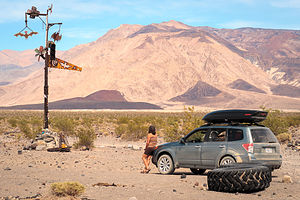 It only gets stranger from hereAfter our hike, we said goodbye to David, and headed back out from whence we came along the South Eureka Road. However, this time when we reached the Death Valley / Big Pine Road, we headed west towards Big Pine and the road to Saline Valley. When we got to the turnout for the Saline Valley road, we pulled over and had a discussion as to whether or not we had enough gas to make the 40 mile drive to the warm springs and back. This involved many calculations with guestimates as to gallons remaining and mpg to expect off-roading. After determining that we did, but not by much, we decided to drive out to Big Pine anyway, just to be safe. It was about a 30-mile diversion, but one we felt would give us peace of mind.
It only gets stranger from hereAfter our hike, we said goodbye to David, and headed back out from whence we came along the South Eureka Road. However, this time when we reached the Death Valley / Big Pine Road, we headed west towards Big Pine and the road to Saline Valley. When we got to the turnout for the Saline Valley road, we pulled over and had a discussion as to whether or not we had enough gas to make the 40 mile drive to the warm springs and back. This involved many calculations with guestimates as to gallons remaining and mpg to expect off-roading. After determining that we did, but not by much, we decided to drive out to Big Pine anyway, just to be safe. It was about a 30-mile diversion, but one we felt would give us peace of mind.
The road to the Saline Valley Warms Springs from Big Pine Road was 40 miles, just as our drive to Eureka Dunes was yesterday; however, it was far rougher and more desolate. During our entire drive, we did not encounter another vehicle. I was so glad we had filled up our gas tank. Fortunately, everything went smoothly (well maybe smoothly is a bad word to describe the bumpy journey) and it only took us 2 ½ hours.
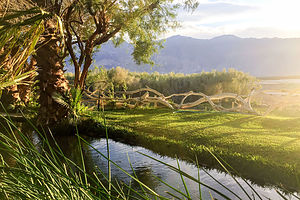 ParadiseThe most interesting site along the way was the rusty old remains of an old mining operation, where we stopped to take a break and some photos.
ParadiseThe most interesting site along the way was the rusty old remains of an old mining operation, where we stopped to take a break and some photos.
The turnoff for the Warm Springs can be easy to miss, so we carefully watched our odometer to hit the magic 32.7.
The Warm Springs road was significantly rougher and definitely achieved the goal of keeping the timid of heart and non high-clearance vehicles out. About 4 miles into our bumpy drive to the Palm Spring Oasis, we came to a tall post with metal bats hanging from it. I guess we were getting close.
Soon the oasis came into view, like a mirage rising from a dry stark landscape. It was surreal.
We expected to find the Palm Oasis campground empty – after all, we had not encountered another soul on our way in, but to our surprise it was a thriving community whose inhabitants were definitely there for a longer duration than we had planned. I felt a little bit like a tourist in a foreign country – easily standing out, not understanding the culture and rules, etc.
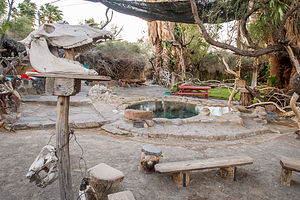 The Pools at the OasisThe place was amazing – prettier and better maintained than most commercial hot springs. There were several soaking pools made of concrete, rock, and tile as well as showers (with soap and shampoo supplied (to use before entering the pool. In addition, there was a fully stocked bathroom, with Costco size toilet paper packages, cleaning products, air fresheners, etc. The grounds were beautiful, with planted shaded grass areas and creative fencing made from branches. If I ever had an image of Paradise, this was pretty darn close to it.
The Pools at the OasisThe place was amazing – prettier and better maintained than most commercial hot springs. There were several soaking pools made of concrete, rock, and tile as well as showers (with soap and shampoo supplied (to use before entering the pool. In addition, there was a fully stocked bathroom, with Costco size toilet paper packages, cleaning products, air fresheners, etc. The grounds were beautiful, with planted shaded grass areas and creative fencing made from branches. If I ever had an image of Paradise, this was pretty darn close to it.
As we were setting up our tent in the area above the pools, a pair of wild burros wandered by and began rummaging through the contents of our absent neighbor’s camping boxes and even his truck, which was foolishly left with the hatch in the back open. Despite Herb’s lack of experience in burro management, he bravely began waving his arms and yelling at them. They dispersed for approximately 2 minutes before resuming their mischievous behavior. Herb repeated this exercise several times before giving up and asking me to walk through the camp and find the owner of the vehicle, which I attempted with no success.
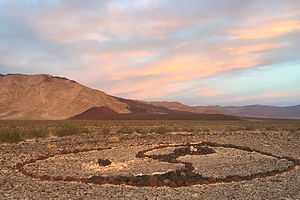 Sunset in Saline ValleyFinally, we gave up, took our beach chairs and a bottle of wine, and went to sit in the grassy area that looked out over the Saline Valley. It wasn’t long before a gentleman came over and asked us if this was our first time here – I guess we weren’t blending in as well as I thought. Maybe it was the beach chairs and the wine glasses.
Sunset in Saline ValleyFinally, we gave up, took our beach chairs and a bottle of wine, and went to sit in the grassy area that looked out over the Saline Valley. It wasn’t long before a gentleman came over and asked us if this was our first time here – I guess we weren’t blending in as well as I thought. Maybe it was the beach chairs and the wine glasses.
I think his main purpose for talking to us was to make sure that we understood the campground etiquette regarding the campground’s caretaker, “Lizard” Lee. He explained that after the main pool was done being cleaned, Lizard liked to soak for a bit by himself – in other words, “stay out of the pool then.” We assured him that we would behave.
This place certainly didn’t feel like part of a National Park – I guess no ranger talk tonight. In fact, it seems like the National Park Service kind of just ignores this place and lets Lizard and his sycophants do what they want. They certainly do keep it nice though.
After a soak in one of the “Lizard free” pools, we went back to our campsite to make dinner.
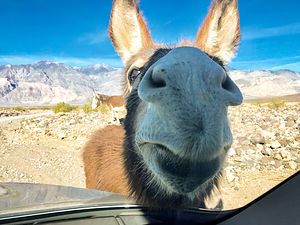 Good Riddance!!That night was probably the worst night I ever spent tent camping. The winds were so strong that it sounded like a jet was coming through the tent. At some point, the jet began to hee-haw – the damn burros were back and they were now going through our camping boxes, which we foolishly left outside. Herb, the newly minted “burro whisperer,” flew out of the tent, yelling and waving his arms. It was about as effective as his last attempts. The next morning we found burro teeth marks in our Rubbermaid storage boxes.
Good Riddance!!That night was probably the worst night I ever spent tent camping. The winds were so strong that it sounded like a jet was coming through the tent. At some point, the jet began to hee-haw – the damn burros were back and they were now going through our camping boxes, which we foolishly left outside. Herb, the newly minted “burro whisperer,” flew out of the tent, yelling and waving his arms. It was about as effective as his last attempts. The next morning we found burro teeth marks in our Rubbermaid storage boxes.
We had originally planned to spend another night at the oasis, but we had had enough. Exhausted, we packed up the next morning and started out to retrace our long 40-mile bumpy drive back to the paved Big Pine Road. Oh, but before were even a mile on our journey, a group of burros approached our car to say goodbye. One actually pressed his nose against our windshield. I think we had made the right decision to leave early.
Once again, we did not pass a single vehicle along the way. They were all still back there with Lizard and those damn burros.
Description
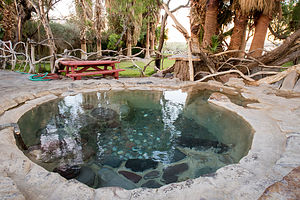 Lizard's PoolThe Saline Valley is a large, deep, and arid valley that runs along the western edge of Death Valley National Park. It is known for its salt, borax, abandoned mines, and controversial, clothing-optional hot springs located in a series of palm oases.
Lizard's PoolThe Saline Valley is a large, deep, and arid valley that runs along the western edge of Death Valley National Park. It is known for its salt, borax, abandoned mines, and controversial, clothing-optional hot springs located in a series of palm oases.
The Saline Valley road is a very rough dirt road that runs for 95 miles from SR 168 in the north to SR 190 in the south, ranging in elevation from 1,094 to 7,593 feet. High ground clearance 4WD vehicles and full-sized spare times are strongly recommended.
Coming from the north the drive to the warms springs is a rough 40 miles. The turnoff from the Saline Valley road onto the Warm Springs Road, which can be difficult to find, is at the 32.7 mile point. Here, the road gets even rougher. At about 4 miles there is a tall post with metal bats hanging from it. Once you see that, you are almost there.
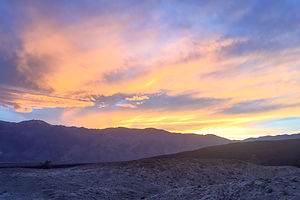 More sunset in Saline ValleyA few miles further is a serious of gorgeous warm springs, each with multiple soaking pools. Although these springs weren’t unheard of during the mining heydays, it wasn’t until the 1960s that they became popular among hippies who developed a semi-permanent camp here. The residents soon set to work making home improvements – taming the wild springs into several concrete, rock, and tile soaking pools, building showers, dishwashing facilities, and latrines, building creative fences out of branches, and planting shady grassy areas.
More sunset in Saline ValleyA few miles further is a serious of gorgeous warm springs, each with multiple soaking pools. Although these springs weren’t unheard of during the mining heydays, it wasn’t until the 1960s that they became popular among hippies who developed a semi-permanent camp here. The residents soon set to work making home improvements – taming the wild springs into several concrete, rock, and tile soaking pools, building showers, dishwashing facilities, and latrines, building creative fences out of branches, and planting shady grassy areas.
In 1994 the Saline Valley became part of Death Valley National Park and put under the watchful eye of the NPS. The camp was dispersed and visitation was limited to 30 days. One man named Wizard remained and eventually became the caretaker for the site. When he passed away, Lee “Lizard” Greenwell took his place and is still there today.
Today the springs are not found on any NPS maps and rangers are hesitant to tell visitors how to find them. Meanwhile, Lizard and his sycophants live on happily enjoying their bit of paradise.
Death Valley - Eureka Dunes
Tuesday, April 25, 2017 - 8:00am by Lolo137 miles and 3 hours from our last stop - 1 night stay
Travelogue
 Desert BloomThis was to be a very different type of visit to Death Valley than our previous ones in that we would be heading out to some of its remote areas in our Subaru Forester.
Desert BloomThis was to be a very different type of visit to Death Valley than our previous ones in that we would be heading out to some of its remote areas in our Subaru Forester.
As one should always do before heading out on 4WD roads, we stopped at the Furnace Creek Visitor Center to discuss road conditions with a ranger and to get some advice as to what would be appropriate for us. Although our Subaru is very capable off road, it’s not exactly a rock crawler, nor are its tires as beefy as the trucks devoted to this sport.
We originally thought we would drive out to the Racetrack, where the rocks mysteriously move when no one is looking, but the ranger told us that our tires would be eaten up by the rocks in no time, and we would most likely have to be towed out. Okay, forget that idea.
However, he did give us two good suggestions – the 40-mile drive to Eureka Dunes and/or also the 40-mile drive down the Saline Valley to the hot springs, both of which he felt our Subaru could handle without a problem. He even said that if we left soon, we should be able to get to Eureka Dunes with several hours of daylight to spare.
 Crankshaft Junction on the way to Eureka DunesWe left the Visitor Center and headed north towards Scotty’s Castle. When we came to the junction for Scotty’s Castle/Ubehebe Crater, we took a left towards the crater. Actually, we had no choice as the road to Scotty’s Castle was so damaged by storms that it is closed, and expected to be so for quite some time. Rather than going all the way to the crater, at about 2.8 miles after the junction we turned right onto the Death Valley / Big Pine Road.
Crankshaft Junction on the way to Eureka DunesWe left the Visitor Center and headed north towards Scotty’s Castle. When we came to the junction for Scotty’s Castle/Ubehebe Crater, we took a left towards the crater. Actually, we had no choice as the road to Scotty’s Castle was so damaged by storms that it is closed, and expected to be so for quite some time. Rather than going all the way to the crater, at about 2.8 miles after the junction we turned right onto the Death Valley / Big Pine Road.
The dirt-and-gravel Big Pine Road was well-maintained and definitely navigable for a 2WD vehicle. At about the 18 mile point, we came to our first landmark – Crankshaft Junction, named for the castoff engine parts that less-fortunate travelers left at this remote site. It made you think a little bit.
We continued on for another 12 miles before turning left onto the South Eureka Road to the dunes. The road was a bit rougher and sandier than the Big Pines Road, but comfortably doable in our 4WD Subaru Forester. I’m not sure if it is advisable with 2WD, but that could certainly be confirmed by talking to a ranger.
 Cocktail hour at Eureka DunesIt was another 10 miles along the South Eureka Road to the campground near the base of the very impressive Eureka Dunes, the largest dune in California and the second largest in the entire U.S. The campground was dry (no water or flush toilets) and had only four designated sites. Fortunately, there was one left, which we grabbed. A bit further down the road, there are a few more dispersed campsites without the amenities of a picnic table and fire ring.
Cocktail hour at Eureka DunesIt was another 10 miles along the South Eureka Road to the campground near the base of the very impressive Eureka Dunes, the largest dune in California and the second largest in the entire U.S. The campground was dry (no water or flush toilets) and had only four designated sites. Fortunately, there was one left, which we grabbed. A bit further down the road, there are a few more dispersed campsites without the amenities of a picnic table and fire ring.
As striking as the dunes were, an even lovelier view from our campsite was of the Last Chance Mountains, rising 700 feet from the Eureka Valley floor, brightly painted by the evening light.
We spent a lovely evening, enhanced with wine and cheese, with our very interesting camping neighbor David, a professional photographer that currently lives in India in the same village as the Dalai Lama. He was visiting the states for two months because his photographs are being exhibited at several galleries throughout the country. Later that evening, he went back to his camper and returned with a copy of his recently published book, a stunning collection of portraits of Tibetan migrants. We were honored when he offered to take our photo with my cell phone.
 Making the dunes singThe next morning, Herb and I set out on our hike up the dune, an exercise I always find more grueling than anticipated – 2 steps forward, 1 step back. Plus, although we did get a relatively early start in the morning, it was already getting pretty hot up there.
Making the dunes singThe next morning, Herb and I set out on our hike up the dune, an exercise I always find more grueling than anticipated – 2 steps forward, 1 step back. Plus, although we did get a relatively early start in the morning, it was already getting pretty hot up there.
It was actually a little tricky finding the summit, as each time we climbed to the top of a ridge, we saw another one higher. The guidebook said that it was 700 feet high, so we kept track of our progress on Herb’s altimeter watch.
There were portions of the hike that were so steep that I actually had to bend my body forward into the incline and use my hands as well. I looked like a gorilla. Meanwhile, each step on the really steep parts set off what looked like a river of sand, starting about 3 feet above us and continuing right below us for another dozen or so feet. The patterns we created were beautiful.
 Almost thereBesides the intriguing visual effect, we were also making the dunes “sing.” Singing sand dunes are quite rare and there are only about 40 of them in the entire world. The singing is really more of a booming sound, and it is triggered by an avalanching movement of sand.
Almost thereBesides the intriguing visual effect, we were also making the dunes “sing.” Singing sand dunes are quite rare and there are only about 40 of them in the entire world. The singing is really more of a booming sound, and it is triggered by an avalanching movement of sand.
After a few false summits, Herb’s altimeter watch eventually showed a gain of 690 feet – good enough. We looked around and saw no higher ridge, so we declared ourselves at the top.
The way down was a heck of a lot more fun and took about a third of the time it took us on the way up. I felt like I was running down a hill of pudding.
All in all, the hike was a very rewarding, and exhausting, 2.1 mile round-trip.
Description
 Desert Sunset with "Leonard the Drone"The Eureka Dunes are located in an enclosed basin at 3,000 foot elevation in the northwest corner of Death Valley National Park. Rising 700 feet above sea level, they are the tallest sand dunes in California and possibly the tallest in all of North America.
Desert Sunset with "Leonard the Drone"The Eureka Dunes are located in an enclosed basin at 3,000 foot elevation in the northwest corner of Death Valley National Park. Rising 700 feet above sea level, they are the tallest sand dunes in California and possibly the tallest in all of North America.
They are reached via a series of rutted dirt and gravel roads subject to washout, so reaching this area requires a 4WD vehicle.
The climb to the summit is about 2 miles (RT) and should be done early in the day or later in the evening when the temperature is cooler. The climb to the summit is challenging, as the slopes are steep and the loose sand gives way beneath your feet. During the steepest parts of the hike, the sand avalanches in rivulets and begins to sing. This “singing sand” phenomena, resulting from the friction of the sand grains sliding against each other, sounds like the bass note of a pipe organ. The views at the top are worth the struggle to get there.
As tall as these impressive dunes are, they are dwarfed by the colorfully striped limestone walls of the Last Chance Mountains, which rise 4,000 feet above the valley floor.
Rhyolite
Tuesday, April 25, 2017 - 7:45am by Lolo218 miles and 4.5 hours from our last stop
Travelogue
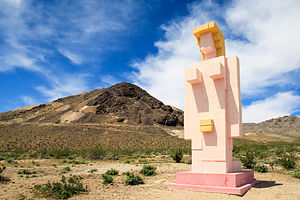 Lady Desert: The Venus of NevadaThe next morning, we headed east on 120, a beautiful road that brought us into Nevada, and then south to the town of Beatty, near the eastern entrance to Death Valley.
Lady Desert: The Venus of NevadaThe next morning, we headed east on 120, a beautiful road that brought us into Nevada, and then south to the town of Beatty, near the eastern entrance to Death Valley.
However, we couldn’t just breeze through Beatty without a stop at one of our favorite outdoor sculpture museums – the Goldwell Open Air Museum in Rhyolite. This place is literally in the middle of nowhere.
The museum, which is open to the public 24 hours a day 7 days a week, has seven monumental outdoor sculptures that are colossal not only in their scale, but in their dramatic setting amongst mountains and the Mojave Desert. It was precisely this stark setting that attracted a group of Belgian artists in the 1980s to choose this location to create their art.
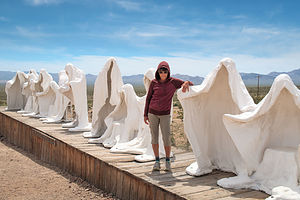 Where's Waldo?My two favorites sculptures were by Albert Szukalski, and they both involve an unusual technique he developed in which a live model is draped in plaster-soaked burlap and has to remain still until the plaster dries enough to stand on its own. I can’t even begin to imagine how uncomfortable this must have been for the models. It gets really, really hot here.
Where's Waldo?My two favorites sculptures were by Albert Szukalski, and they both involve an unusual technique he developed in which a live model is draped in plaster-soaked burlap and has to remain still until the plaster dries enough to stand on its own. I can’t even begin to imagine how uncomfortable this must have been for the models. It gets really, really hot here.
Szukalski’s largest work is entitled “The Last Supper,” and it consists of 12 white ghostly shapes arranged as in Leonardo da Vinci’s painting of the same name. The shapes have no faces or bodies – just drapes hanging on an invisible form.
My second favorite was aptly called “Ghost Rider.” As in Szukalski’s other works, a ghostly draped figure – minus the body inside – stood beside an actual real bicycle, as if it was getting ready to go for a ride.
 Ghost Rider of RhyoliteI also took the time this visit to walk the entire maze, which according to Strava was a tenth of a mile.
Ghost Rider of RhyoliteI also took the time this visit to walk the entire maze, which according to Strava was a tenth of a mile.
For anyone passing through this area, the Goldwell Open Air Museum is truly worth a visit.
Just up the road from Goldwell is the Rhyolite Ghost Town. Coming from the East Coast, ghost towns are still a bit of a novelty for us, and we can’t resist a poke around. Each of them has its own not-so unique story – someone discovers gold, thousands descend on area, town springs up, mines dry up, people leave, buildings crumble, tourists come.
At its height, Rhyolite had a population of 5,000, hotels, stores, a school for 250 children, an opera house, a railroad depot, an ice plant, an ice cream parlor, two electric plants, foundries and machine shops, and a hospital. Rhyolite even had a red light district which drew women from as far away as San Francisco.
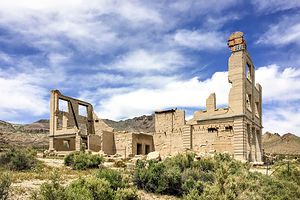 The old Cook Bank of RhyoliteToday, there is not much left of this once lively and boisterous town. Not nearly as much to explore as there is at Bodie State Historic Park near Bridgeport, California, where we really got a feel for what life must have been like in one of these boom towns.
The old Cook Bank of RhyoliteToday, there is not much left of this once lively and boisterous town. Not nearly as much to explore as there is at Bodie State Historic Park near Bridgeport, California, where we really got a feel for what life must have been like in one of these boom towns.
All that remains intact in Rhyolite is a beautiful, old railway depot and the Bottle House, a home made from 50,000 beer and liquor bottles. The most photographed image in Rhyolite is of the ruins of the old three-story Cook Bank. In fact, it is the most photographed ruin in the entire state of Nevada.
As always, Rhyolite had been a very interesting stop, but it was time to head into Death Valley and figure out where we would be camping for the night.
Description
The small town of Rhyolite is located just off Highway 394, near the eastern edge of Death Valley National Park. It is only 35 miles from the Furnace Creek Visitor Center.
For such a tiny, remote town, there are two very interesting sights, which make it a very worthwhile side trip from Death Valley:
Goldwell Open Air Museum
 Ghostly PaletteThe Goldwell Open Air Museum is located just off State Highway 374, near the Rhyolite Ghost Town. The museum, which is open to the pubic 24 hours a day 7 days a week, has seven monumental outdoor sculptures that are colossal not only in their scale, but in their dramatic setting amongst mountains and the Mojave Desert.
Ghostly PaletteThe Goldwell Open Air Museum is located just off State Highway 374, near the Rhyolite Ghost Town. The museum, which is open to the pubic 24 hours a day 7 days a week, has seven monumental outdoor sculptures that are colossal not only in their scale, but in their dramatic setting amongst mountains and the Mojave Desert.
It was this dramatic setting that led a group of prominent Belgian artists in the 1980s to choose this location as a place to create art freely. The museum was organized in 2000 after the death of Albert Szukalski, the Belgian artist who created the site’s first sculptures. His unusual technique involved molding shapes by draping plaster-soaked burlap over live models until the plaster dried enough to stand on its own. His largest work, “The Last Supper,” consists of 12 large white ghostly shapes arranged as in da Vinci’s painting of the same name. Another one of is pieces entitled “Ghost Rider” is a plaster figure getting ready to mount a bicycle.
Today artists continue to create in this spectacular and challenging landscape as part of an art residency and workshop program.
An on-site visitor center with exhibits is open from 10:00 am to 4:00 pm, Monday through Saturday. In summer it often closes by 2:00 pm because of the heat. Admission is free.
Rhyolite Ghost Town
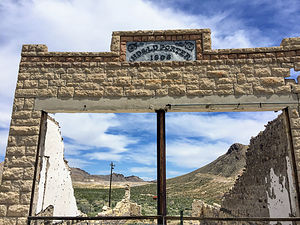 Rhyolite Ghost TownLike many western towns, Rhyolite sprang up from nowhere when in 1904 Shorty Harris and E. L. Cross discovered quartz on a nearby hill. Soon thousands of gold-seekers flocked to the area, settling in a sheltered desert basin which was named Rhyolite because of the silica-rich volcanic rock in the area. By 1908, the population grew close to 5,000, and the town had hotels, stores, a school for 250 children, an opera house, a railroad depot, an ice plant, two electric plants, foundries and machine shops, and a hospital. Rhyolite even had a red light district which drew women from as far away as San Francisco. One enterprising miner named Tom T. Kelly built a Bottle House, made from 50,000 beer and liquor bottles. That house is one of the buildings that still remains today.
Rhyolite Ghost TownLike many western towns, Rhyolite sprang up from nowhere when in 1904 Shorty Harris and E. L. Cross discovered quartz on a nearby hill. Soon thousands of gold-seekers flocked to the area, settling in a sheltered desert basin which was named Rhyolite because of the silica-rich volcanic rock in the area. By 1908, the population grew close to 5,000, and the town had hotels, stores, a school for 250 children, an opera house, a railroad depot, an ice plant, two electric plants, foundries and machine shops, and a hospital. Rhyolite even had a red light district which drew women from as far away as San Francisco. One enterprising miner named Tom T. Kelly built a Bottle House, made from 50,000 beer and liquor bottles. That house is one of the buildings that still remains today.
As with so many other boom towns, Rhyolite declined as quickly as it rose. The financial panic of 1907 made it more difficult to raise capital, and soon mines began to close and the banks to fail. By 1910, production had significantly slowed and there were only 611 residents left in town. In 1911, the mine and mill were closed down and by 1916 the light and power in the town were turned off.
After 1920, Rhyolite became a tourist attraction and a setting for motion pictures. Today visitors can see several remnants of the town’s glory days: the railway depot, the Bottle House, and the ruins of the three-story Cook Bank and an old jail.
Lee Vining (Mono Lake)
Monday, April 24, 2017 - 6:45pm by Lolo300 miles and 5.5 hours from our last stop - 1 night stay
Travelogue
 Approach to Mono LakeBecause of the record-breaking snowfall in the Sierras this past winter, the only way to get across the Sierras (besides going all the way down to Bakersfield) was Route 50 through South Lake Tahoe.
Approach to Mono LakeBecause of the record-breaking snowfall in the Sierras this past winter, the only way to get across the Sierras (besides going all the way down to Bakersfield) was Route 50 through South Lake Tahoe.
As a New Jerseyite for 60 years, I am still intrigued by this idea of “going to the snow,” where you can literally drive from 80 degree sunny weather to a winter wonderland within 4 hours. As we drove through the tiny town of Kyburz on 50, more and more snow appeared on the sides of the road. It even hailed on us for a good part of the way.
Eventually we crossed over and started heading down 395, also known as the Eastern Sierra Scenic Byway – and for good reason. For most of our drive, we had jaw-dropping views of snow-covered mountains both to west and east.
 Herb relaxing in the Lake View LodgeKnowing we would not get to Death Valley that first day, we stopped at a motel in Lee Vining for the night. It was unseasonably cold and so windy that there were white caps on Mono Lake. We had hoped to eat at our favorite gas station (Whoa Nellie Deli), but were told that it was still closed for the season until the following week. The town was pretty much dead, so we made do for dinner with supplies from our cooler.
Herb relaxing in the Lake View LodgeKnowing we would not get to Death Valley that first day, we stopped at a motel in Lee Vining for the night. It was unseasonably cold and so windy that there were white caps on Mono Lake. We had hoped to eat at our favorite gas station (Whoa Nellie Deli), but were told that it was still closed for the season until the following week. The town was pretty much dead, so we made do for dinner with supplies from our cooler.
Lee Vining is worthy of much more than a mere drive there. It is in a beautiful location with so many wonderful things to do. I have tried to describe some of them in the Description section of this stop (see Tab above).
Description
 Sierra BoundLee Vining is a small town along the Eastern Sierra Scenic Byway (Highway 395) located on the southwest shore of Mono Lake and the eastern entrance to Yosemite National Park.
Sierra BoundLee Vining is a small town along the Eastern Sierra Scenic Byway (Highway 395) located on the southwest shore of Mono Lake and the eastern entrance to Yosemite National Park.
Some highlights in the area include:
Mono Lake
Mono Lake is located just off Highway 395 near the town of Lee Vining, California, 13 miles east of Yosemite National Park. Mono Lake is extremely unique. First of all, at over 1 million years of age, it is one of the oldest continuously existing lakes in the continent. Secondly, it is about 2 ½ times as salty as the sea and about 80 times as alkaline. This is because Sierra streams flow into Mono Lake bringing trace amounts of salts and minerals, but the lake has no outlet other than evaporation. As a result, the concentration levels of salts and minerals keeps growing each year. Thirdly, and the main reason Mono Lake is so popular, are the hundreds of spectacular “tufa towers” that rise from the lake. These intriguing calcium-carbonate sculptures were formed beneath the water when carbonates in the water combined with calcium from freshwater springs feeding into the lake. As lake levels dropped, these extraordinary-looking knobs, spires, and minarets became exposed. Most of the towers visible in the lake are from 200 to 900 years old and rise as high as 30 feet above the water.
Panum Crater is a small, dormant crater located just south of Mono Lake and east of Highway 395. The Crater, which last erupted in 1325 AD, is a perfect example of a rhyolitic plug-dome volcano. A marked and maintained trail leads around the rim of the crater, with spectacular views of the Eastern Sierras, Mono Lake and the Mono Basin. The crater is about 2,000 feet across. A side trip leads down into the lava dome at the center of the volcano where there are bizarre rock formations and huge chunks of obsidian everywhere. The rim and trail into the dome is about 2 ½ miles long with a total elevation gain of about 200 feet.
Black Point is a flat-topped volcanic hill on the north side of Mono Lake. It last erupted about 13,000 years ago beneath the waters of what was once a much deeper Mono Lake. As the cinders and lava cooled and hardened under water, the top split open to form several hundred-yard-long cracks, or canyon-like fissures, measuring from 20 to 50 foot deep and only a few feet wide. When the waters of Mono Lake receded after the Ice Age, Black Point became a peninsula. It is the only fully exposed underwater volcano on earth.
There really is no trail to the Black Point Fissures, and they can be challenging to find because they are not visible until you are standing at their edge. The best thing to do is to start at the BLM trailhead and follow the lines of footprints up the gently sloping butte across cinders and ash to the level plateau on top of the point. The fissures can be found about 800 feet beyond the small rocky promontory near the southeast corner, radiating northwards away from a small line of cliffs along the south edge of the summit plateau.
All the fissures have sloping sides so they can be entered without much difficulty. Be sure to do so to see the unusual knobby textures and colors along their walls.
On the way down, expansive views of Mono Lake and the Sierras lie before you.
Lundy Canyon is located about seven miles north of Lee Vining, along the eastern boundary of Yosemite National Park. The Lundy Canyon trail is the backdoor into the 20 Lakes Basin area of the Hoover Wilderness and along its way are some of the best waterfalls in the Eastern Sierras. The trailhead is located at the end of Lundy Lake Road, about 2 miles past Lundy Lake. Although the entire trail goes to Saddleback Lake (in 6 miles), most people turn around at 2.2. miles when the trail becomes much steeper and treacherous alongside a steep wall of unstable shale. For much of the hike, the trail rises alongside Mill Creek, passing several beaver ponds, lower Lundy Falls near the beginning of the trail, and the Upper Falls near the turnaround point where the trail begins to climb out of the canyon.
Home
Wednesday, February 22, 2017 - 9:45am by Lolo155 miles and 3.5 hours from our last stop - 1 night stay
